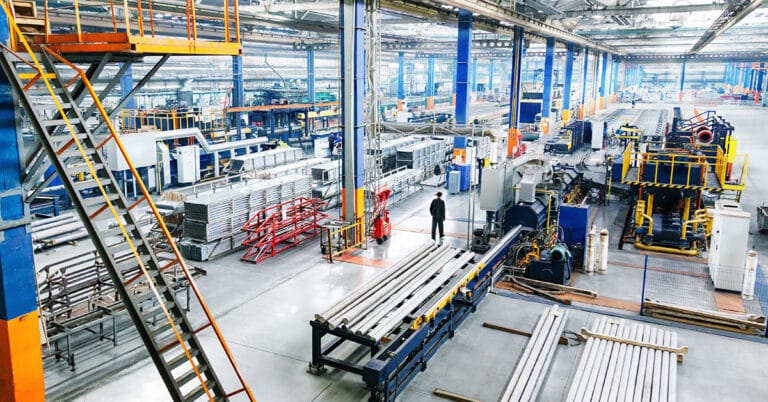Change is constant in the manufacturing industry. Companies must adapt to product upgrades, safety requirements, and efficiency improvements while minimizing risks to productivity and quality. This is where change management in manufacturing becomes critical. Without a structured approach, even small adjustments can lead to breakdowns, safety hazards, or costly rework.
A strong change management plan helps manufacturers balance efficiency with safety. By following proven change management strategies, organizations can reduce risks, improve communication, and create a foundation for continuous improvement across facilities. Effective change management transforms a change initiative from a potential disruption into a competitive advantage.
What is change management in manufacturing?
Improvement suggestions are valuable, but implementing them should never be left to chance or the initiative of someone with a good idea. Manufacturing processes are complex, and a change made with the best of intentions could have unforeseen consequences. These might include quality defects that result in warranty claims, more frequent breakdowns or even product contamination.
To avoid this, every factory needs a manufacturing change management process. This is a formal, structured approach to requesting, reviewing and implementing organizational changes. It begins with a change request, which could be raised by manufacturing, engineering, quality or maintenance, and ends when the new or updated standard operating procedure (SOP), is adopted.
The difference between informal suggestions and a formalized process is accountability. While an individual may propose a change to save time or improve efficiency, without a documented change management plan there is no guarantee the risks will be reviewed, stakeholders consulted, or tests conducted. By contrast, a structured change management process ensures each idea follows a clear path:
- Change request: Logged and circulated to stakeholders.
- Review: Manufacturing, engineering, quality, and maintenance evaluate feasibility and risks.
- Testing: Any proposed adjustments are validated under controlled conditions.
- Engineering change order (ECO): Formal approval triggers implementation.
- SOP update: Documentation is revised, and the change becomes part of standard practice.
Examples of why a request might be raised include:
- Someone in production has an idea that will save them time
- Switching to a different conveyor belt material will extend time between failures and save on industrial maintenance work
- A kaizen event has identified that changing the order of operations will reduce handling work
- Quality adjustments advise extending the drying time of a coating in order to reduce warranty claims
- Engineering has been notified that one of the components used in the product is going end-of-life and they need to switch to an alternative
Every request needs to go through a thorough review where stakeholders are invited to comment. This should result in concerns being identified and, most likely, testing being required. If test results are satisfactory the change is ready to be implemented. This typically requires some form of change order, which sets in motion the relevant changes and notifications needed.
The importance of change management
The most important reason for operating a manufacturing change management process is to avoid unintended consequences. The benefits are:
- Safe working conditions: Careful review by maintenance and safety ensures no potentially hazardous equipment modifications are made.
- Cost reductions: A successful change management process provides a structured way of proposing and implementing improvements. Manufacturing operations become more efficient and productive and waste is reduced or avoided.
- Communication: The proposed change is shared with all the stakeholders, giving them an opportunity to raise any concerns or highlight potential risks. For example, a proposed alteration to machine guarding that will reduce unloading time should be reviewed by safety and will need maintenance to advise on the work involved in making the alterations.
- Risk elimination: A formal process ensures risks are assessed, tests conducted as needed, and that all possible consequences are identified and evaluated.
- Documentation: Once the change is accepted SOPs must be updated. The release of these is usually the signal that the change is live.
- Education: Those affected by the change, for example, line workers and maintenance technicians, must be told about it and taught what they need to do differently.
Consider this example: A manufacturer decides to alter a machine’s drying time to improve efficiency. Without formal testing, the change seems harmless. However, this adjustment could result in incomplete curing, leading to widespread product defects and potentially triggering a costly recall. This illustrates why manufacturing change management is critical: it ensures that risks are identified, documented and prevented before they affect operations or customers.
Beyond efficiency and safety, effective change management also supports regulatory compliance. Standards from ISO, the FDA, and OSHA often require thorough documentation and risk assessments for engineering change management. A formal change process provides the detail evidence auditors and regulators expect, protecting manufacturers from fines, recalls, or reputational damage.
Manufacturing change management best practices
There is no single “best” process: Every manufacturing organization needs to develop one that works for them. However, some best practices do stand out for change management in the manufacturing industry:
- SOPs are essential: SOPs provide a standardized way of working, and audits test compliance. When a change is implemented, this must be done via the SOP to ensure it sticks.
- A defined request system: It’s vital that a change request goes to everyone with a stake in manufacturing, which is something only a standardized system can ensure. Without this, valuable input from functions such as maintenance and quality will likely be overlooked.
- Risk management: When stakeholders review change requests, they must identify potential problems and consequences. This should trigger further analysis and testing if the request is to move forward. Failing to assess risks invites unintended consequences.
- Communications and training: An effective system keeps all stakeholders in the loop regarding the proposal and its implementation status. It also initiates education in the change and any training that may be necessary. To give an example, a machine modification that simplifies unloading may require maintenance technicians to gain access from a different direction to replace a filter.
- Implementation: There must be a defined date when the change goes live, with everyone affected understanding what they need to do differently. Documentation of the implementation is also needed in case of any follow-up, for example, in case of customer returns that can be traced back to the change.
Utilizing technology for change management in manufacturing
An effective change management process involves multiple functions within an organization and requires careful documentation. While this ensures safety and accountability, it can also slow down reviews, testing, and implementation. New digital technologies now help manufacturers streamline the change process, improve communication, and reduce delays:
- Connected worker programs: These put tablets containing SOPs and other instructions in the hands of line workers and enable rapid communication of changes.
- Computerized maintenance management systems (CMMS): Many ideas for improving production processes need input from maintenance. The computerized maintenance management system (CMMS) provides a visible way to manage and follow up on change orders.
- Industry 4.0 technology: When production equipment is instrumented with advanced sensors and communications capabilities, process changes can often be implemented faster and their impact quickly measured.
- Digital twin technology: A growing tool in digital transformation, digital twins allow manufacturers to simulate proposed changes in a virtual environment before applying them on the factory floor. By modeling equipment, processes, and workflows digitally, organizations can test for risks, predict outcomes, and fine-tune changes without disrupting live operations.
Together, these technologies enable more effective change management strategies by accelerating reviews, reducing uncertainty, and creating reliable data for decision-making.
Common challenges in manufacturing change management
Even with a formal change management process, manufacturers often face barriers that slow progress. Key challenges include:
- Resistance to change: Employees or leadership may hesitate to adopt new processes. Clear communication and early involvement help reduce pushback.
- Lack of ownership: Without defined responsibility, change requests can stall. Assigning accountability keeps initiatives moving forward.
- Poor documentation: Incomplete records create confusion or repeated mistakes. Accurate documentation ensures traceability and consistency.
- Training gaps: Changes fail if employees aren’t properly trained. Building education into the change plan supports long-term adoption.
- Over-reliance on manual processes: Paper-based systems slow progress and invite errors. Digital tools streamline communication and manage change more effectively.
Addressing these challenges with effective change management strategies helps manufacturers improve adoption and sustain continuous improvement.
Implementation needs communication
Improving efficiency, productivity and safety means making alterations to manufacturing processes. Engineering changes, such as different materials or components, can also ripple through to production equipment. These changes must be evaluated and implemented in a controlled manner where all stakeholders are consulted and consequences considered.
The factory maintenance function plays a large role in making manufacturing improvements and should be part of the process. Digital technology can improve communication and accelerate the implementation of improvements, but communication across functions will always be a vital part of change management.
As a pioneer in the field of outsourced industrial maintenance, ATS helps manufacturers implement change management and other manufacturing improvements. Contact us for more information.






